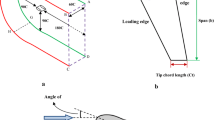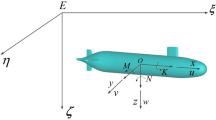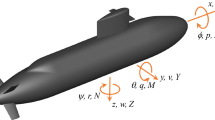Abstract
Three models with different submarine structure were established firstly, and then, flow fields of the three different structures were computed and compared through FLUENT software. As a result, the virtual reality of the flow characteristics of submarines was also researched and presented through some contours in this paper. As known from the result, the flow field speed around the submarine was significantly reduced but the pressure on the submarine was enlarged if the submarine had a podium, mainly due to a certain vortex existing around the podium. Besides, after the adoption of a cruciform tail, a significant improvement was shown in the flow field around the submarine and flow field on the surface, thus indicating the severe impact generated by the submarine tail on the flow field characteristics of the submarine. Therefore, the tail type of the submarine should be designed strictly during the design process of submarine structure. Finally, BP neural network was applied to compute the total resistance coefficient of the submarine and compare it with the calculation result of CFD to obtain a small relative error. It indicated that it was reliable to use BP neural network to predict the total resistance coefficient of the submarine.



















Similar content being viewed by others
References
Iglesias O, Lastras G, Canals M et al (2012) The BIG’95 submarine landslide–generated tsunami: a numerical simulation. J Geol 120(1):31–48
Font R, García-Peláez J (2013) On a underwater vehicle hovering system based on blowing and venting of ballast tanks. Ocean Eng 72:441–447
Cremonesi M, Frangi A, Perego U (2011) A Lagrangian finite element approach for the simulation of water-waves induced by landslides. Comput Struct 89(11):1086–1093
Chase N, Michael T, Carrica PM (2013) Overset simulation of a underwater vehicle and propeller in towed, self-propelled and maneuvering conditions. Int Shipbuild Prog 60(1):171–205
Wei W, Xu Q, Wang L et al (2014) GI/Geom/1 queue based on communication model for mesh networks. Int J Commun Syst 27(11):3013–3029
Li JQ, He SQ, Ming Z (2015) An Intelligent Wireless Sensor Networks System With Multiple Servers Communication. Int J Distrib Sensor Netw 07:1–9
Zhu Z, Xiao J, Li JQ et al (2015) Global path planning of wheeled robots using multi-objective memetic algorithms. Integr Comput-Aid Eng 22(4):387–404
Yan Q, Yu FR, Gong Q, Li J (2016) Software-defined networking (SDN) and distributed denial of service (DDoS) attacks in cloud computing environments: a survey, some research issues, and challenges. IEEE Commun Surv Tutor 18(1):602–622
Zeng WD, Wang YS, Yang QF (2010) Numerical calculation of flow noise of submarine with full appendages. ACTA Armament 31(9):1204–1208
Zhang N, Shen HC, Yao HZ (2005) Validation of numerical simulation on resistance and flow field of submarine and numerical optimization of submarine hull form. J Ship Mech 9(1):1–13
Lin Q, Chen J (2013) A novel micro-population immune multiobjective optimization algorithm. Comput Oper Res 40(6):1590–1601
Zhang N, Yang RY, Shen CH (2011) Numerical towing tank and CFD simulation for the underwater vehicle powering performance. J Ship Mech 15(1–2):17–24
Wei Wei, Yong Qi (2011) Information potential fields navigation in wireless ad-hoc sensor networks. Sensors 11(5):4794–4807
Atkins DJ (1996) Computational hydrodynamics for the underwater vehicle—recent development. International symposium on naval submarine, vol 5, pp 10
Lu YT, Zhang HX, Pan XJ (2008) Numerical simulation of flow-field and flow-noise of a fully appendage submarine. J Vib Shock 27(9):142–146
Hu B, Pan G, Du XU (2012) Numerically calculating viscous flow around a full-appendage submarine using multi-block structural grid. J Northwest Polytech Univ 30(5):689–693
Lv Z, Halawani A, Feng S et al (2015) Touch-less interactive augmented reality game on vision-based wearable device. Pers Ubiquit Comput 19(3–4):551–567
Lv Z, Tek A, Da Silva F et al (2013) Game on, science-how video game technology may help biologists tackle visualization challenges. PLoS One 8(3):e57990
Acknowledgement
The project is supported by the National Natural Science Foundation (61074151) and (11371002) and Specialized Research Fund for the Doctoral Program of Higher Education (20131101110048).
Author information
Authors and Affiliations
Corresponding author
Ethics declarations
Conflict of interest
We declared that this manuscript was not submitted and published in the other journal.
Rights and permissions
About this article
Cite this article
Liu, Qm., Gao, X. Research on the virtual reality of impact of appendages on the flow characteristics of submarines based on neural networks and CFD. Neural Comput & Applic 29, 1293–1301 (2018). https://doi.org/10.1007/s00521-017-2866-2
Received:
Accepted:
Published:
Issue Date:
DOI: https://doi.org/10.1007/s00521-017-2866-2




